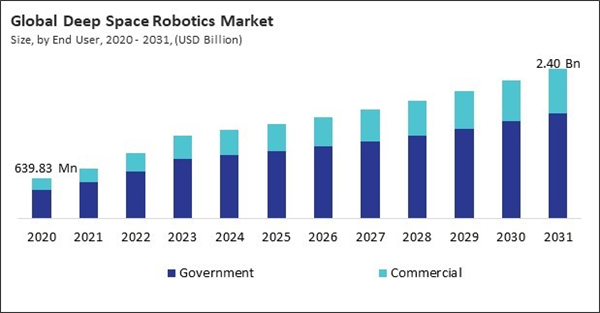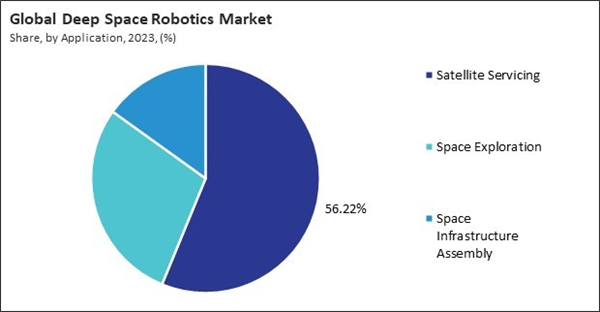The Global Deep Space Robotics Market size is expected to reach $2.40 billion by 2031, rising at a market growth of 7.8% CAGR during the forecast period.
The Artemis program and Mars missions further highlight the region’s dominance in robotic space technologies. With continued investment in AI-driven robotics and deep space automation, North America is expected to maintain its leadership in this market. Thus, the North America segment recorded 41% revenue share in the market in 2023. The region benefits from strong government support, with NASA leading numerous deep space exploration initiatives. Additionally, private companies such as SpaceX and Blue Origin are driving advancements in space robotics for satellite servicing, planetary exploration, and space infrastructure development.
The increasing interest in space tourism and commercial space exploration drives demand for deep space robotics. Private companies like SpaceX, Blue Origin, and Virgin Galactic are pioneering commercial spaceflight initiatives to make space travel accessible for civilians. With the commercialization of space tourism, robotic systems are essential to support spacecraft operations, automate routine maintenance, and assist in ensuring passenger safety. In conclusion, growing interest in space tourism and commercial space exploration drives the market's growth.
Additionally, robotic arms and manipulators are increasingly essential for spacecraft operations, particularly for performing intricate tasks such as satellite servicing, cargo handling, and scientific instrumentation deployment. These robotic systems improve mission efficiency by enabling remote-controlled and autonomous operations, reducing astronaut workload, and minimizing the risks associated with extravehicular activities. Therefore, the rising demand for robotic arms and manipulators for spacecraft operations drives the market's growth.
However, developing deep space robotics requires substantial financial investment due to the need for specialized components, extensive research, and rigorous testing. Unlike terrestrial robots, space-grade robotic systems must be engineered to withstand extreme radiation, microgravity, and vacuum conditions. This necessitates high-performance materials and advanced manufacturing techniques, significantly increasing production costs. In conclusion, the high costs associated with developing and deploying deep space robotics are impeding the market's growth.
The Artemis program and Mars missions further highlight the region’s dominance in robotic space technologies. With continued investment in AI-driven robotics and deep space automation, North America is expected to maintain its leadership in this market. Thus, the North America segment recorded 41% revenue share in the market in 2023. The region benefits from strong government support, with NASA leading numerous deep space exploration initiatives. Additionally, private companies such as SpaceX and Blue Origin are driving advancements in space robotics for satellite servicing, planetary exploration, and space infrastructure development.
The increasing interest in space tourism and commercial space exploration drives demand for deep space robotics. Private companies like SpaceX, Blue Origin, and Virgin Galactic are pioneering commercial spaceflight initiatives to make space travel accessible for civilians. With the commercialization of space tourism, robotic systems are essential to support spacecraft operations, automate routine maintenance, and assist in ensuring passenger safety. In conclusion, growing interest in space tourism and commercial space exploration drives the market's growth.
Additionally, robotic arms and manipulators are increasingly essential for spacecraft operations, particularly for performing intricate tasks such as satellite servicing, cargo handling, and scientific instrumentation deployment. These robotic systems improve mission efficiency by enabling remote-controlled and autonomous operations, reducing astronaut workload, and minimizing the risks associated with extravehicular activities. Therefore, the rising demand for robotic arms and manipulators for spacecraft operations drives the market's growth.
However, developing deep space robotics requires substantial financial investment due to the need for specialized components, extensive research, and rigorous testing. Unlike terrestrial robots, space-grade robotic systems must be engineered to withstand extreme radiation, microgravity, and vacuum conditions. This necessitates high-performance materials and advanced manufacturing techniques, significantly increasing production costs. In conclusion, the high costs associated with developing and deploying deep space robotics are impeding the market's growth.
Driving and Restraining Factors
Drivers
- Growing Interest in Space Tourism and Commercial Space Exploration
- Rising Demand for Robotic Arms and Manipulators for Spacecraft Operations
- Increasing Space Exploration Missions by Government and Private Entities
Restraints
- High Costs Associated with the Development and Deployment of Deep Space Robotics
- Limited Availability of Space-Qualified Materials and Components
Opportunities
- Increasing Demand for Autonomous Robots in Interplanetary and Lunar Colonization Missions
- Increasing Focus on Space Debris Removal and Orbital Sustainability Initiatives
Challenges
- Limited Repair and Maintenance Capabilities Once Deployed in Deep Space
- Power Generation and Energy Storage Constraints in Deep Space Environments
Solution Outlook
Based on solution, the market is characterized into remotely operated vehicles, remote manipulator system, software, and services. The software segment garnered 47% revenue share in the market in 2023. The increasing reliance on advanced software solutions for autonomous navigation, data processing, and robotic control has been a key driver for this segment’s growth. Deep space exploration missions require sophisticated algorithms for machine learning, artificial intelligence, and real-time decision-making, enhancing the efficiency and precision of robotic systems.Application Outlook
By application, the market is divided into space exploration, satellite servicing, and space infrastructure assembly. The space exploration segment witnessed 29% revenue share in the market in 2023. The increasing number of interplanetary missions, lunar explorations, and Mars rovers has significantly contributed to the segment’s dominance. Space agencies and private companies heavily invest in robotic systems to conduct scientific research, terrain mapping, and resource identification in deep space environments.End User Outlook
Based on end user, the market is segmented into government and commercial. The government segment procured 72% revenue share in the market in 2023. National space agencies, including NASA, ESA, Roscosmos, CNSA, and ISRO, have been at the forefront of deep space exploration, investing heavily in robotic systems for planetary exploration, space research, and satellite deployment. Governments allocate substantial budgets to support long-term space missions, focusing on technological advancements in robotics, AI, and autonomous systems.Regional Outlook
Region-wise, the market is analyzed across North America, Europe, Asia Pacific, and LAMEA. The Europe segment witnessed 28% revenue share in the market in 2023. The European Space Agency (ESA) and aerospace giants like Airbus and Thales Alenia Space have been actively involved in robotic space missions. Europe contributes to planetary exploration, satellite servicing, and space debris removal.List of Key Companies Profiled
- Space Applications Services NV/SA
- Lunar Resources, Inc.
- Honeybee Robotics (Ensign-Bickford Industries, Inc.)
- Ceres Robotics Inc.
- Astrobotic Technology, Inc.
- Northrop Grumman Corporation
- Redwire Corporation (Made In Space, Inc.)
- iRobot Corporation
- Metecs, LLC
- Motiv Space Systems Inc.
Market Report Segmentation
By End User
- Government
- Commercial
By Application
- Satellite Servicing
- Space Exploration
- Space Infrastructure Assembly
By Solution
- Services
- Remotely Operated Vehicles
- Remote Manipulator System
- Software
By Geography
- North America
- US
- Canada
- Mexico
- Rest of North America
- Europe
- Germany
- UK
- France
- Russia
- Spain
- Italy
- Rest of Europe
- Asia Pacific
- China
- Japan
- India
- South Korea
- Singapore
- Malaysia
- Rest of Asia Pacific
- LAMEA
- Brazil
- Argentina
- UAE
- Saudi Arabia
- South Africa
- Nigeria
- Rest of LAMEA
Table of Contents
Chapter 1. Market Scope & Methodology
Chapter 2. Market at a Glance
Chapter 3. Market Overview
Chapter 4. Global Deep Space Robotics Market by End User
Chapter 5. Global Deep Space Robotics Market by Application
Chapter 6. Global Deep Space Robotics Market by Solution
Chapter 7. Global Deep Space Robotics Market by Region
Chapter 8. Company Profiles
Companies Mentioned
- Space Applications Services NV/SA
- Lunar Resources, Inc.
- Honeybee Robotics (Ensign-Bickford Industries, Inc.)
- Ceres Robotics Inc.
- Astrobotic Technology, Inc.
- Northrop Grumman Corporation
- Redwire Corporation (Made In Space, Inc.)
- iRobot Corporation
- Metecs, LLC
- Motiv Space Systems Inc.
Methodology

LOADING...










